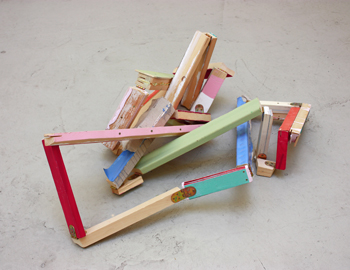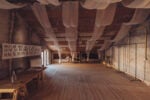Guillermo Mora – Quizás mañana haya desaparecido

Le sculture di Guillermo Mora sembrano cogliere la condizione liquida del soggetto nello snodo critico e globale dell’attualità.
Comunicato stampa
La galleria e x t r a s p a z i o presenta dal 4 ottobre la mostra Quizás mañana haya desaparecido (Forse domani sarà scomparso), prima personale italiana di Guillermo Mora.
NO FIXED FORM
Minime. Silenziose. Ansiose. Precarie. Fluide. Reiette. Fragili. Turbate. Attraenti. Plasmatiche. Tentanti. Post-pop.
Le sculture di Guillermo Mora sembrano cogliere la condizione liquida del soggetto nello snodo critico e globale dell'attualità. Nella loro molteplicità materica e nella loro informe e instabile consistenza esse transitano come presenze discrete in un universo oggettuale in cui ancora inopportunamente, tediosamente e inadeguatamente striscia un'estetica spettacolare e perfettamente manipolata, vacuo retaggio di un'opulenza oggettuale post-Ottanta ed emblema simbolico del feticismo post-capitalistico tecnocratico.
Ma queste piccole sculture no fixed form, manipolate attraverso un processo pittorico post-esistenzialista che attraversa lo stato di solidificazione, o che si reifichino come tali dopo essere state rubate alla loro anonima casualità di oggetti da strada (dunque homeless materials), o che si assemblino fra loro per empatia, o che sembrino essere state masticate come caramellose chewing gum, ci catapultano nello stadio dell'incertezza. Al tempo stesso esse ci rituffano in quell'estetica della precarietà che artisti di controtendenza come Jason Rhoades, David Hammons, Gabriel Orozco, Rirkrit Tiravanija, Bojan Šarčević, Dieter Roth (e molti altri e per molti versi) hanno adoperato come critica al sistema tardo-capitalistico, galvanizzato e strutturato come universo del vuoto oggettuale, iper-sensazionalistico e che ora appare in tutta la sua molestia e pateticità.
Le sculture di Mora, in realtà, hanno la più intima e quasi ludica volontà di reclinare sul proprio Sé e indagare sul proprio senso di inadeguatezza, di disagio e di sospetto che, suo malgrado, si coagula con lo stato di indeterminatezza globale.
In esse appare un barlume di critica al reale e l'imbarazzo del perfezionismo (illusorio e affabulistico) oggettuale e sistemico di un universo clonato, menzognero, improvvido e molto poco realistico nel quale si è navigati in superficie e ora si è annegati.
Quizás mañana haya desaparecido è quasi un aforisma dell'artista, la sua beffarda consapevolezza della liquidità del reale, dell'Io, della materia, dell'oggetto, del pensiero. Quizás mañana haya desaparecido non pone la questione apocalittica dell'esistenza del mondo bensì innesca il dubbio dell'habitus in cui un Sé dialogico (e tutto il suo universo fantasmatico) si potrebbe ricollocare.
Teresa Macrì
Roma, settembre 2011
Guillermo Mora è nato ad Alcalà de Henares (Spagna) nel 1980; vive e lavora tra Roma e Madrid. Tra le sue mostre personali ricordiamo: nel 2011 Dos episodios y un estadio (cur. P. Lag), LAB, Injuve, Murcia, Spagna. Nel 2010 Una pregunta diaria, Formato Cómodo Gallery, Madrid. Nel 2009: De un soplo, Casa de la Entrevista, Alcalá de Henares; Tú la llevas (cur. I. Tejeda), Casa de Cultura, El Campello, Alicante; Un paseo entre el dibujo, la pintura y un más allá (cur. V. Torrente), Centro de Arte Joven de la Comunidad de Madrid, Madrid. Il suo lavoro è stato esposto nelle seguenti mostre collettive: nel 2011 Nomadismi (cur. T. Macrì), Real Academia de España en Roma; nel 2010: XII International Award for Young Artists, Luís Adelantado Gallery, Valencia; Explum 2010, International Contemporary Art Award, Puerto Lumbreras, Spagna. Nel 2009: XX CIRCUITOS de Artes Plásticas y Fotografía, Sala de Arte Joven, Comunidad de Madrid, Madrid. Nel 2008: XI Biennial of Visual Arts, Pamplona, Spagna; X International Show Union Fenosa, MACUF, La Coruña, Spagna; IX UNICAJA Biennial of Visual Arts, Palacio Episcopal, Málaga. Nel 2007: Generación 2007, Caja Madrid Grants and Awards, La Casa Encendida, Madrid | La Capella, Barcellona, | Museo de la Pasión and Iglesia de las Francesas, Valladolid | Atarazanas, Valencia | Santa Inés, Siviglia; Y si no han muerto, todavía están vivos, Museo Municipal de Coimbra, Portogallo; Big Sky, LG Space, The School of the Art Institute of Chicago, Chicago, USA.
g u i l l e r m o m o r a
quizás mañana haya desaparecido
4th october | 19 november 2011
On 4th October e x t r a s p a z i o gallery presents
Quizás mañana haya desaparecido (Maybe tomorrow will be gone), Guillermo Mora's first solo exhibition in Italy.
NO FIXED FORM
Minimal. Silent. Anxious. Precarious. Fluid. Outcast. Fragile. Disturbed. Attractive. Plasmatic. Tempting. Post-pop.
Guillermo Mora's sculptures seem to seize the liquid condition of the subject in the critical and global pivot of topicality. In their materic multiplicity and in their formless and unstable consistency they transit as discrete presences in an objectual universe where - still inopportunely, tediously and inadequately - a spectacular and perfectly manipulated aesthetic drags on, vacuous legacy of a post-eighties objectual opulence and symbolic emblem of technocratic post-capitalistic fetishism.
But these little no fixed form sculptures which are manipulated by means of a post-existentialist pictorial process that crosses the state of solidification, or which reify themselves as such after having been robbed of their anonymous randomness as objects found in the street (hence homeless materials), or which assemble together through empathy, or which appear to have been masticated like syrupy chewing gum, catapult us into the stage of uncertainty.
At the same time they plunge us back into that aesthetic of precariousness which countertrend artists like Jason Rhoades, David Hammons, Gabriel Orozco, Rirkrit Tiravanija, Bojan Šarčević, Dieter Roth (and many others and in many ways) have employed as a criticism of the late-capitalist system, galvanised and structured as a universe of objectual vacuity, hyper-sensationalistic, which now appears in all its vexation and pathetic nature.
Mora's sculptures actually have the most intimate and almost playful will to recline on their own Self and inquire into their own sense of inadequacy, of unease and suspicion which, reluctantly, coagulates with the state of global indeterminateness.
What appears in them is a glimmer of criticism of the real and the embarrassment of perfectionism (illusory and fairytale-like), the objectual and systemic perfectionism of a universe which is cloned, mendacious, improvident and far from realistic, in which we have sailed on the surface and are now drowning.
Quizás mañana haya desaparecido is almost an aphorism by the artist, his mocking awareness of the liquidity of the real, of the Ego, of matter, of the object, of thought. Quizás mañana haya desaparecido does not pose the apocalyptic question of the world's existence but rather triggers doubt about the habitus in which a dialogical Self (and its whole spectral universe) might be relocated.
Teresa Macrì
Rome, September 2011
Guillermo Mora was born in Alcalà de Henares (Spain) in 1980; lives and works between Rome and Madrid. Among his solo exhibitions we mention: Dos episodios y un estadio (cur. P. Lag), LAB, Injuve, Murcia, Spain (2011); Una pregunta diaria, Formato Cómodo Gallery, Madrid (2010); De un soplo, Casa de la Entrevista, Alcalá de Henares; Tú la llevas (cur. I. Tejeda), Casa de Cultura, El Campello, Alicante; Un paseo entre el dibujo, la pintura y un más allá (cur. V. Torrente), Centro de Arte Joven de la Comunidad de Madrid, Madrid (2009).Among his group exhibitions: Nomadismi (cur. T. Macrì), Real Academia de España en Roma, Rome (2011); XII International Award for Young Artists, Luís Adelantado Gallery, Valencia; Explum 2010, International Contemporary Art Award, Puerto Lumbreras, Spain (2010); XX CIRCUITOS de Artes Plásticas y Fotografía, Sala de Arte Joven, Comunidad de Madrid, Madrid (2009); XI Biennial of Visual Arts, Pamplona, Spain; X International Show Union Fenosa, MACUF, La Coruña, Spain; IX UNICAJA Biennial of Visual Arts, Palacio Episcopal, Málaga (2008); Generación 2007, Caja Madrid Grants and Awards, La Casa Encendida, Madrid | La Capella, Barcelona | Museo de la Pasión and Iglesia de las Francesas, Valladolid | Atarazanas, Valencia | Santa Inés, Sevilla; Y si no han muerto, todavía están vivos, Museo Municipal de Coimbra, Portugal; Big Sky, LG Space, The School of the Art Institute of Chicago (2007).



